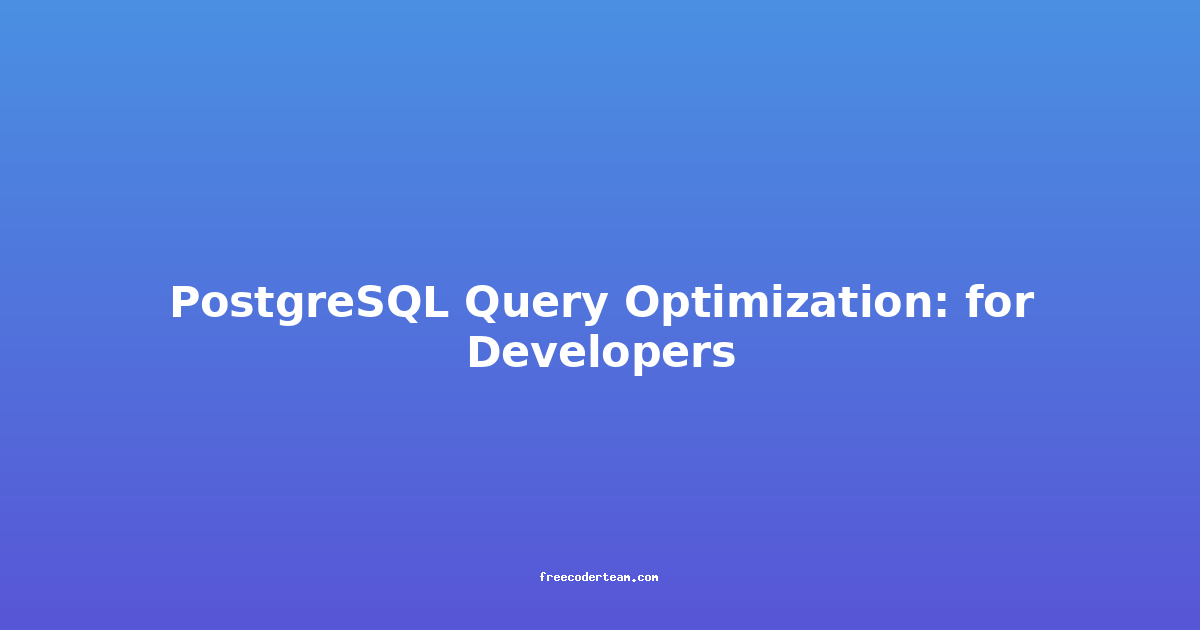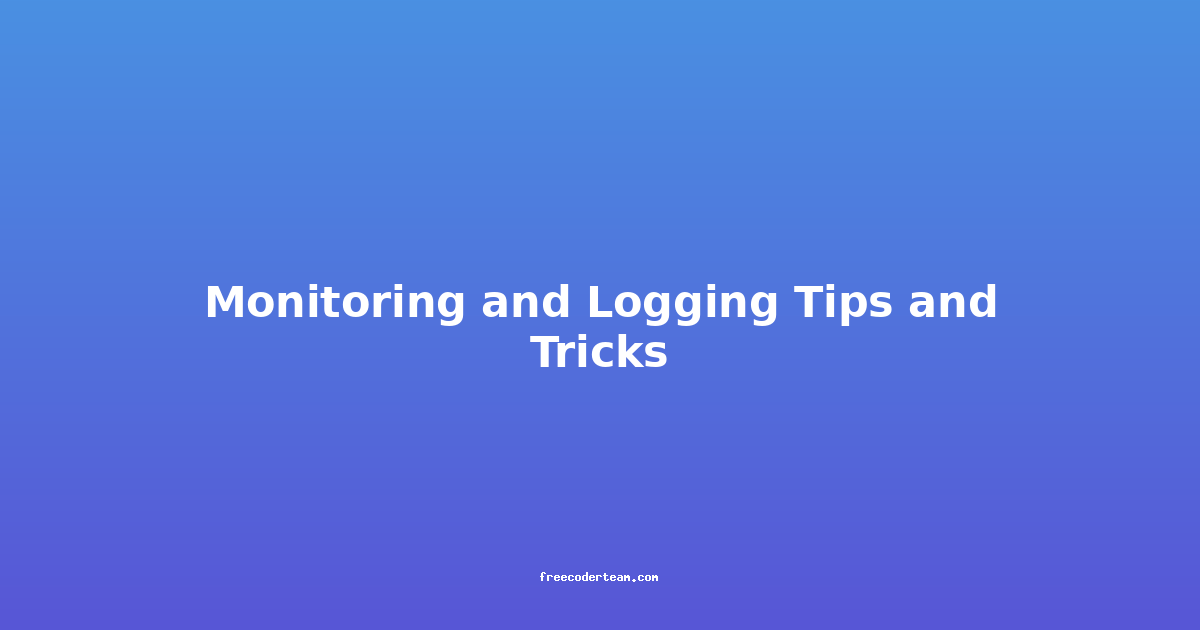PostgreSQL Query Optimization: A Guide for Developers
PostgreSQL is a powerful open-source relational database management system (RDBMS) known for its robust features, scalability, and performance. However, even with its capabilities, query performance can sometimes become a bottleneck in applications. Optimizing PostgreSQL queries is crucial for ensuring that your application remains fast, responsive, and efficient, especially as the volume of data grows.
In this blog post, we'll explore best practices, actionable insights, and practical examples to help developers optimize PostgreSQL queries. Whether you're a beginner or an experienced developer, these techniques will help you write more efficient SQL queries and improve your application's performance.
Table of Contents
Understanding Query Performance
Before diving into optimization techniques, it's essential to understand what affects query performance. PostgreSQL uses a cost-based query optimizer to determine the most efficient way to execute a query. Factors that influence query performance include:
- Data Volume: The amount of data being queried.
- Index Usage: Whether the query can leverage indexes to reduce the number of rows scanned.
- Query Complexity: The number of joins, subqueries, and functions used.
- Hardware Resources: CPU, memory, and disk I/O.
Optimizing queries involves reducing the cost of execution by minimizing the number of rows scanned, leveraging indexes, and avoiding unnecessary computations.
Best Practices for Query Optimization
1. Use Proper Indexing
Indexes are one of the most effective tools for improving query performance. They allow PostgreSQL to quickly locate data without scanning the entire table. However, not all indexes are created equal, and improper indexing can lead to performance degradation.
Types of Indexes
- B-Tree Index: The most common type, suitable for equality and range queries.
- Gin Index: Useful for full-text search and JSON data.
- Hash Index: Rarely used in PostgreSQL due to its limitations.
When to Use Indexes
- Columns in WHERE Clauses: Index columns that are frequently used in
WHEREconditions. - Foreign Keys: Index columns used in
JOINoperations. - Ordering: Index columns used in
ORDER BYorGROUP BYclauses.
Example: Creating an Index
CREATE INDEX idx_users_email ON users(email);
When Not to Use Indexes
- Columns with low cardinality (e.g., boolean columns).
- Columns that are rarely queried.
2. Avoid SELECT *
Using SELECT * retrieves all columns from a table, which can be inefficient, especially if you only need a few columns. Retrieving unnecessary data increases I/O and memory usage.
Better Practice
-- Instead of:
SELECT * FROM users WHERE id = 1;
-- Use:
SELECT id, name, email FROM users WHERE id = 1;
3. Optimize Joins
Joins are a common source of query performance issues, especially when dealing with large datasets. Here are some tips to optimize joins:
Use Appropriate Join Types
- INNER JOIN: Use when you only need matching rows.
- LEFT JOIN: Use when you need all rows from the left table, even if there are no matches.
- CROSS JOIN: Avoid unless necessary, as it can result in a Cartesian product.
Ensure Proper Indexing
Index columns used in JOIN conditions to speed up the matching process.
Example: Optimizing a Join
-- Poorly optimized:
SELECT u.name, o.order_date
FROM users u
JOIN orders o ON u.id = o.user_id;
-- Optimized:
-- Ensure indexes on users.id and orders.user_id
CREATE INDEX idx_users_id ON users(id);
CREATE INDEX idx_orders_user_id ON orders(user_id);
-- Query remains the same, but execution is faster due to indexes.
4. Use EXPLAIN for Query Analysis
The EXPLAIN command is a powerful tool for understanding how PostgreSQL executes a query. It provides insights into the query plan, including the type of scan used, the number of rows scanned, and the cost of execution.
Using EXPLAIN
EXPLAIN SELECT * FROM users WHERE email = 'john.doe@example.com';
Example Output
Seq Scan on users (cost=0.00..40.00 rows=1 width=36)
Filter: (email = 'john.doe@example.com'::text)
If the output shows a Seq Scan (sequential scan), it means the query is scanning the entire table. This is inefficient and suggests that an index might be needed.
Using EXPLAIN ANALYZE
To get actual execution statistics, use EXPLAIN ANALYZE:
EXPLAIN ANALYZE SELECT * FROM users WHERE email = 'john.doe@example.com';
Example Output
Seq Scan on users (cost=0.00..40.00 rows=1 width=36) (actual time=0.042..0.042 rows=1 loops=1)
Filter: (email = 'john.doe@example.com'::text)
Rows Removed by Filter: 999
Planning Time: 0.103 ms
Execution Time: 0.058 ms
5. Limit Data Retrieval
When querying large datasets, it's often unnecessary to retrieve all rows. Use LIMIT and OFFSET to paginate results, and consider using WHERE clauses to filter data as early as possible.
Example: Paginating Results
-- Retrieve the first 10 users
SELECT id, name, email
FROM users
WHERE created_at > '2023-01-01'
LIMIT 10;
-- Retrieve the next 10 users
SELECT id, name, email
FROM users
WHERE created_at > '2023-01-01'
ORDER BY id
LIMIT 10 OFFSET 10;
6. Avoid Functions in WHERE Clauses
Using functions in WHERE clauses can prevent PostgreSQL from using indexes. Instead, try to rewrite the query to avoid functions or use functional indexes.
Example: Avoiding Functions
-- Poorly optimized:
SELECT * FROM users WHERE lower(email) = 'john.doe@example.com';
-- Optimized:
SELECT * FROM users WHERE email = 'john.doe@example.com';
If you must use functions, consider creating a functional index:
CREATE INDEX idx_users_email_lower ON users(lower(email));
Practical Examples
Example 1: Indexing for Faster Queries
Problem
You have a users table with millions of rows, and queries on the email column are slow.
Solution
Create an index on the email column.
Implementation
CREATE INDEX idx_users_email ON users(email);
-- Query before indexing:
EXPLAIN SELECT * FROM users WHERE email = 'john.doe@example.com';
-- Query after indexing:
EXPLAIN SELECT * FROM users WHERE email = 'john.doe@example.com';
Expected Output
Before indexing:
Seq Scan on users (cost=0.00..40.00 rows=1 width=36)
Filter: (email = 'john.doe@example.com'::text)
After indexing:
Index Scan using idx_users_email on users (cost=0.14..8.16 rows=1 width=36)
Index Cond: (email = 'john.doe@example.com'::text)
Example 2: Optimizing Joins
Problem
You have a users table and an orders table, and a query joining these tables is slow.
Solution
Ensure proper indexing on the JOIN columns.
Implementation
-- Create indexes
CREATE INDEX idx_users_id ON users(id);
CREATE INDEX idx_orders_user_id ON orders(user_id);
-- Query before indexing:
EXPLAIN SELECT u.name, o.order_date
FROM users u
JOIN orders o ON u.id = o.user_id;
-- Query after indexing:
EXPLAIN SELECT u.name, o.order_date
FROM users u
JOIN orders o ON u.id = o.user_id;
Expected Output
Before indexing:
Nested Loop (cost=0.00..40.00 rows=1 width=36)
-> Seq Scan on users u (cost=0.00..20.00 rows=1 width=36)
-> Seq Scan on orders o (cost=0.00..20.00 rows=1 width=36)
Filter: (o.user_id = u.id)
After indexing:
Nested Loop (cost=0.14..8.16 rows=1 width=36)
-> Index Scan using idx_users_id on users u (cost=0.14..8.16 rows=1 width=36)
Index Cond: (id = o.user_id)
-> Index Scan using idx_orders_user_id on orders o (cost=0.14..8.16 rows=1 width=36)
Index Cond: (user_id = u.id)
Example 3: Using EXPLAIN to Analyze Queries
Problem
You suspect that a query is slow, but you're not sure why.
Solution
Use EXPLAIN ANALYZE to analyze the query plan.
Implementation
EXPLAIN ANALYZE SELECT * FROM users WHERE email = 'john.doe@example.com';
Expected Output
Index Scan using idx_users_email on users (cost=0.14..8.16 rows=1 width=36) (actual time=0.042..0.042 rows=1 loops=1)
Index Cond: (email = 'john.doe@example.com'::text)
Planning Time: 0.103 ms
Execution Time: 0.058 ms
This output shows that the query is using an index and is executing efficiently.
Conclusion
Optimizing PostgreSQL queries is a critical skill for developers working with large datasets. By following best practices such as proper indexing, avoiding SELECT *, optimizing joins, and using EXPLAIN for query analysis, you can significantly improve query performance.
Remember that query optimization is an iterative process. Regularly monitor your application's performance and use tools like EXPLAIN to identify bottlenecks. With these techniques, you can ensure that your PostgreSQL queries remain efficient and scalable, even as your application grows.
References:
Feel free to explore these techniques further and apply them to your own projects. Happy optimizing! 🚀
Note: Always test changes in a staging environment before deploying them to production to ensure they have the desired effect.




